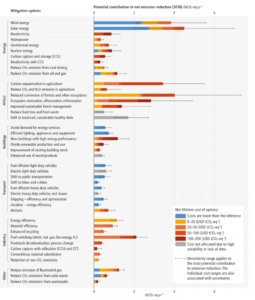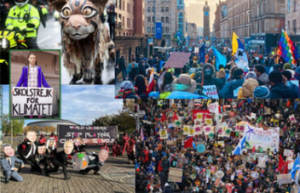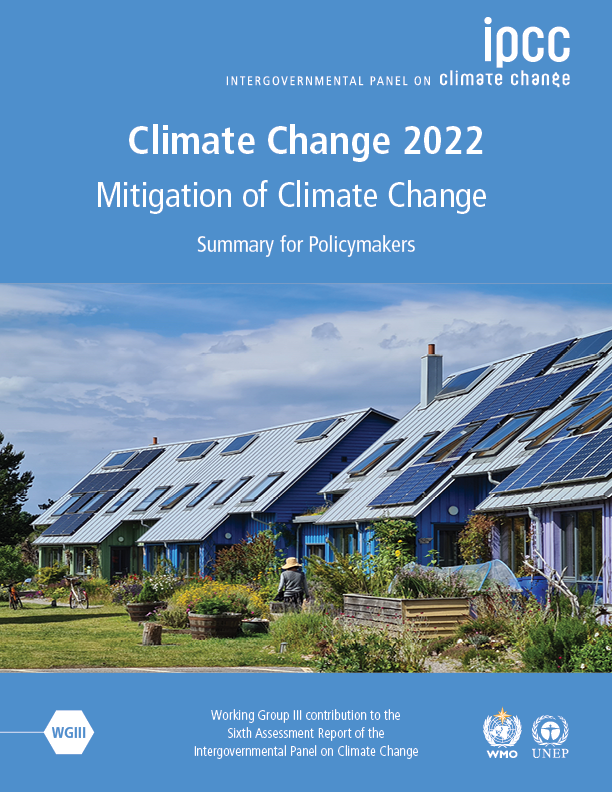
Finally! The 3rd IPCC Report — the one we’ve all been waiting for — is here! This report is all about the solutions to climate change. It lays out all of our current best solutions to global warming.
But before we jump in, let’s get a quick overview of what the IPCC Report is:
The Intergovernmental Panel on Climate Change is a scientific branch of the UN responsible for compiling research from around the globe about the causes, the effects, and the solutions to climate change. It’s the largest peer-reviewed scientific paper in human history, and one of the greatest achievements in science, alongside landing humans on the moon and discovering cures for infectious diseases. (Seriously, this is HUGE!)
Every few years, the IPCC releases a report that takes into account all of the latest research about climate change. They spend the intervening years sifting through thousands of reports from scientists and labs. Once the findings are peer reviewed and verified, they’re then compiled into a report which must be approved by delegations from all 193 UN member states. Then, the final report is released to the public. Because these reports have to get approval from so many different parties, the IPCC Reports are usually quite conservative.
But this report was different. This was the 6th such report from the IPCC, known as AR6 (Assessment Report 6), and they decided to release it in 3 parts. Each part was developed by a different working group:

WG1’s assessment, “The Physical Science Basis,” came out in August 2021, just in time for COP26 in Glasgow. It focused on the scientific consensus about the causes of climate change. And stated unequivocally that humans are causing catastrophic climate change from burning fossil fuels.

WG2’s report, “Impacts, Adaptations and Vulnerability,” came out last month and focused on how climate change has, is, and will affect humanity. It stated that no part of the globe will escape the effects of global warming. Plus, half of humanity is vulnerable to climate catastrophes right now. And as we continue to burn fossil fuels, more and more people will face worse and worse conditions.

Now, we come to the WG3’s report, “Mitigation of Climate Change,” which is the happy ending to this dark trilogy. This report focused on the solutions to climate change and what we can do to get out of this mess. The report’s intention was not to tell us what we should do, but instead to present the facts and give the likely outcomes of different scenarios.
So, what does it say?
The overarching good news is that there are realistic solutions across all sectors to reduce global emissions by half by 2030!
It’s official: WE CAN DO THIS!

There wasn’t really anything new in this IPCC report, which many people might find underwhelming. But it’s actually great news. It means we have everything we need now to transition to a clean economy.
The main takeaway was, we need to STOP BURNING FOSSIL FUELS AND LEAVE THEM IN THE GROUND. We have technologies that can replace fossil fuels almost everywhere they’re used.

This graph illustrates how much each technology would reduce emissions (measured by how long the bar is) and how cheap that technology would be at each level of reduction. Blue means it’s cheaper than our current standard energy. The warm colors are a sliding scale showing how much more it would cost per prevented ton of carbon dioxide equivalent. As we can see, solar and wind technology are the biggest winners. They’re way cheaper than fossil fuels and can deliver the most carbon reductions.
But check out the other big bars. “Carbon sequestration in agriculture” mainly means adopting sustainable agricultural practices that improve soil health. When soil is healthy, it acts as one of Earth’s greatest carbon sinks. Protecting our soil health has been one of those vitally important topics that’s just not sexy enough to get people’s attention. But there are some strong proponents, like Sadhguru, the popular Indian Yogi, who advocate for government policies that improve soil health.
But we’re most excited about “Ecosystem restoration, afforestation, and reforestation”
A.K.A. planting trees! That’s what we’re all about! These are the nature-based solutions that we’re striving every day to fund. And it’s so good to see that it makes such a huge impact! This is why your contributions are so important. Planting trees is not a blue bar — it costs money — but the benefits to ourselves, the planet, and our future generations are immense. Planting trees is a vitally important part of our global strategy to surviving climate change. Which is why we’re so passionate about it. So, thank you to everyone for your contributions!

Unfortunately, there are some other promising solutions that look like they’re not yet very viable. Carbon Capture and Storage (CCS), for example is much more expensive and less effective than many had expected. However, the report points out that CCS is very important to add onto any current and new fossil fuel infrastructure, such as coal power plants, if we are to stay under 1.5℃. But, to bring down the cost and increase the scalability of this technology, there is still some needed innovation before CSS becomes a staple in our climate action game-plan.
Another big takeaway is that climate policy works!
Say it again! Climate👏 policy 👏 works 👏

Around the world, policy directed at reducing emissions has done exactly that. In fact, due to climate policies and our reduced use of coal, oil, and natural gas, it is now unlikely that we’ll hit the worst-case scenario of 4.5 – 5.7℃ of heating! YAY!
Climate policy has improved energy efficiency standards, protected forests and natural ecosystems, and accelerated the use of renewable energy. The actions governments take against climate change are the most profound and we’re encouraged by the immense progress climate policy has had and the opportunities that lie ahead.
Unfortunately, the report’s not all rosy. The report states that it’s unlikely we can keep global warming under 1.5℃. The 1.5℃ target is what the entire world agreed on at the Paris Climate Summit (COP21) in 2015. But when scientists extrapolate the climatic effects of the latest round of NDC’s* that we got from COP26, they determine that we’re on track for 2.4 – 2.8℃ of heating.
*Nationally Determined Contributions are what each UN member state says they will do to decarbonize, reduce and remove emissions.
In Conclusion
We can do this. We can halve our emissions by 2030 and keep our atmosphere under 1.5℃ of warming. It will require swift and drastic action, especially from our governments. But we’ve seen now that effective climate policy can have the positive impacts we need.
We have all the tools we need to transition to a clean, decarbonized economy. Wind and solar are our strongest allies, but we have a plethora of other green technologies that will no doubt become more efficient over time.
We know that we’re already on the right track, we just need to accelerate and scale our actions. We need to keep investing in renewables, divesting from fossil fuels, implementing sound climate policy, and keep planting those trees!
If you feel inspired by the IPCC Report to invest in Earth’s future and plant trees, please visit our Plans page. Then, share us on social media so your friends can get involved in mitigating climate change, too.

